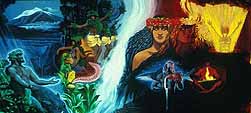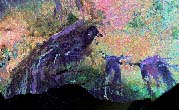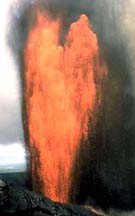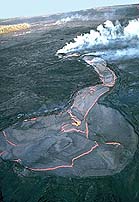
 Many native Hawaiians have a strong religous
belief concerning Pele, the Hawaiian goddess of
fire. According to legend, her spirit resides in the Halemaumau crater on the Kilauea
volcano.
At one time, she had a short and violent marriage to Kamapuaa,
the god of water. As demonstrated in the painting shown here (courtsey
of the artist, Herb Kane), Pele routed Kamapuaa from their
Halemaumau home and, in a rage, chased him with streams of lava
into the sea. This symbolism accurately portrays the often violent
interaction of lava and water associated with explosive hydrovolcanic
eruptions.
Typically, however, Hawaiian eruptions are much more quiescent.
The frequent outpouring of basaltic lava on Kilauea is a fitting
reminder to the faithful that Pele is alive and well.
Many native Hawaiians have a strong religous
belief concerning Pele, the Hawaiian goddess of
fire. According to legend, her spirit resides in the Halemaumau crater on the Kilauea
volcano.
At one time, she had a short and violent marriage to Kamapuaa,
the god of water. As demonstrated in the painting shown here (courtsey
of the artist, Herb Kane), Pele routed Kamapuaa from their
Halemaumau home and, in a rage, chased him with streams of lava
into the sea. This symbolism accurately portrays the often violent
interaction of lava and water associated with explosive hydrovolcanic
eruptions.
Typically, however, Hawaiian eruptions are much more quiescent.
The frequent outpouring of basaltic lava on Kilauea is a fitting
reminder to the faithful that Pele is alive and well.
Hawaiian eruptions are the calmest of the eruption types. They are characterized by the effusive emission of highly fluid basalt lavas with low gas contents. The relative volume of ejected pyroclastic material is less than that of all other eruption types. The hallmark of Hawaiian eruptions is steady lava fountaining and the production of thin lava flows that eventually build up into large, broad shield volcanoes. Eruptions are also common in central vents near the summit of shield volcanoes, and along fissures radiating outward from the summit area. Lava advances downslope away from their source vents in lava channels and lava tubes.
Fissure eruptions are common occurrences on the "Big Island" of Hawaii. They often begin as a line of vents (curatin of fire) that gives way to eruptions concentrated at one or two cental vents lying along the fissure. The Pu'u O'o eruptive series, for example, has been erupting basaltic lava on the Kilauea shield volcano since 1983. These eruptions began on January 3 with a six-kilometer-long curtain of fire on the east rift system of Kilauea. Intermittent fissure eruptions soon gave way to a centralized eruption site on the east rift, about 15 km east of the Kilauea summit caldera, which generated a scoria-and-spatter cone, called the Pu'u O'o volcano. In 1986 the Kupaianaha volcano developed about 3 kilometers farther down rift. It erupted smoothed-surface pahoehoe lava until early 1992. Since that time the main eruption site has been centered at Pu'u O'o.

|

|
|
|
|
The Kilauea summit caldera and east rift system are evident on the above map-view and 3D images. The blue-to-purple regions descending down the southeastern slope of Kilauea (far right) are lava flows generated during the Pu'u O'o eruptive series, through early 1994.
 Central-vent Hawaiian eruptions are noted
for their spectacular jet-like sprays of liquid lava called fire
fountains. These incandescent jets ascend hundreds of
meters into the air. They can occur in short spurts, or last for
hours on end. One of the most spectacular fire fountaining events
ever recorded on Kilauea produced a lava spray 580 m high at the
Kilauea Iki
vent in 1959. However, this is dwarfed by the 1600 m fire
fountain generated by an Hawaiian eruption on the Japanese Island
of Oshima in 1986. The top of fire fountains are often carried
away downwind to produce an airborne curtain of glowing fragments
that showers downward. The indivudual liquid-to-plastic fragments
(clasts) generally cool quickly by radiating their heat into the
atmosphere. Thus, they are chilled and solid by the time they
hit the ground, where they accumulate as cindery fragments called
scoria. However,
during very high eruption rates, the fire fountains become so
dense that the clasts can no longer radiate heat freely into the
atmosphere. These clasts are kept hot by the heat of surrounding
clasts. Under these conditions the molten clasts, spatter, may
hit the ground and fuse
together to form agglutinated spatter cones and spatter ramparts.
If the eruption rates are high enough, spatter-fed flows
(clastogenic lavas) may develop as hot spatter fragments
blend together on the ground and flow away.
Central-vent Hawaiian eruptions are noted
for their spectacular jet-like sprays of liquid lava called fire
fountains. These incandescent jets ascend hundreds of
meters into the air. They can occur in short spurts, or last for
hours on end. One of the most spectacular fire fountaining events
ever recorded on Kilauea produced a lava spray 580 m high at the
Kilauea Iki
vent in 1959. However, this is dwarfed by the 1600 m fire
fountain generated by an Hawaiian eruption on the Japanese Island
of Oshima in 1986. The top of fire fountains are often carried
away downwind to produce an airborne curtain of glowing fragments
that showers downward. The indivudual liquid-to-plastic fragments
(clasts) generally cool quickly by radiating their heat into the
atmosphere. Thus, they are chilled and solid by the time they
hit the ground, where they accumulate as cindery fragments called
scoria. However,
during very high eruption rates, the fire fountains become so
dense that the clasts can no longer radiate heat freely into the
atmosphere. These clasts are kept hot by the heat of surrounding
clasts. Under these conditions the molten clasts, spatter, may
hit the ground and fuse
together to form agglutinated spatter cones and spatter ramparts.
If the eruption rates are high enough, spatter-fed flows
(clastogenic lavas) may develop as hot spatter fragments
blend together on the ground and flow away.
The smallest pyroclasts during fire-fountaining will be carried downwind from near the the top of the eruptive jet. They will chill quickly into small glassy black spheres, dumbells, or teardrop shapes called Pele's tears. During high winds, the teardrop shapes are sometimes drawn out as long filaments, the tails of which can break off to produce Pele's hair. During periods of high vesiculation, basalt foam can quench into the glassy rock recitulite, also known as thread-lace scoria, which has the lowest density of any know rock type.
 The fluid basalt associated with Hawaiian
eruptions sometimes ponds in vents, craters, or broad depressions
to produce lava lakes. In some cases, lava may erupt from a vent
located within a crater, or surface lava flow may pour into a
crater or broad depression. The image shown here is a lava lake
that occupied the Kupaianaha vent on the east rift system of Kilauea
in 1986. Currently active lava lakes occur in only a few locations:
Mt. Erebus in Antarctica, Erta' Ale in Ethiopia, and Nyiragongo in the Congo. The Kilauea
volcano has had an active history of producing lava lakes in its
numerous craters. Perhaps longest-lived lava lake in historic
times was the near permanent lake that occupied the Halemaumau
crater
for most of the hundred-year period between 1823 to 1924. This
lake was destroyed in 1924 by a massive hydrovolcanic eruption. As lava lakes cool, they produce a grey-silver
crust that is usually only a few centimeters thick, as shown here
in the image of the Kupaianaha lava lake. Active lava
lakes contain young crust that is continually destroyed and regenereated.
Convective motion of the underlying lava causes the crust to break
into slabs and sink. This then exposes new lava at the surface
that cools into a new crustal layer which will again break up
into slabs and be recycled into the circulating lava beneath the
crust.
The fluid basalt associated with Hawaiian
eruptions sometimes ponds in vents, craters, or broad depressions
to produce lava lakes. In some cases, lava may erupt from a vent
located within a crater, or surface lava flow may pour into a
crater or broad depression. The image shown here is a lava lake
that occupied the Kupaianaha vent on the east rift system of Kilauea
in 1986. Currently active lava lakes occur in only a few locations:
Mt. Erebus in Antarctica, Erta' Ale in Ethiopia, and Nyiragongo in the Congo. The Kilauea
volcano has had an active history of producing lava lakes in its
numerous craters. Perhaps longest-lived lava lake in historic
times was the near permanent lake that occupied the Halemaumau
crater
for most of the hundred-year period between 1823 to 1924. This
lake was destroyed in 1924 by a massive hydrovolcanic eruption. As lava lakes cool, they produce a grey-silver
crust that is usually only a few centimeters thick, as shown here
in the image of the Kupaianaha lava lake. Active lava
lakes contain young crust that is continually destroyed and regenereated.
Convective motion of the underlying lava causes the crust to break
into slabs and sink. This then exposes new lava at the surface
that cools into a new crustal layer which will again break up
into slabs and be recycled into the circulating lava beneath the
crust.